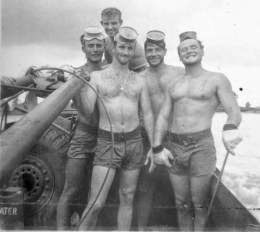Masters of Buckets, Tin cans and Battlewagons. Ahoy men of the Battalion!
Exciting news hot off the press, straight from the broadsheets of the 'Atoll Defender'.
Papa Nui relaunches his iconic Combat Beach Battalion Hat.
Adapting the very best elements of the G.I issue Daisy Mae, the Papa reworks his Battalion Hat for this coming Northern Summer, providing a rousing salute to his heroes of the South Pacific and the homefront workers who back the attack, the Naval Yard crews, the Aircraft plant employees, grease monkeys machinists and carpenters.
Joining forces once again with the John Lofgren Clothing Factory, the Papa ensures that quality is an absolute. The Japanese production takes this new edition Battalion Hat to the next level by using a beautiful mid-weight cotton woven into the tough stuff, rugged Frog Spot Herringbone Twill and twisted yarn Salt and Pepper Chambray, providing you with two great options for your styling pleasure.
Across Continents, Islands and Atolls alike, men trust the Papa! His experience in the Tropics, in the surf, the sea and the sand, guarantees you maximum protection from the harshest elements, the searing Oriental Sun, the burning coral glare and the choking clouds of Volcanic dust. For surf or service the Combat Beach Battalion Hat has you covered. So hunker down with the Papa and choose your shelter.
Become a Battalion Man Now! PayPal the Papa.
$85 buys you your choice of Frog Spot Herringbone Twill or Black Salt and Pepper Chambray, in two size options Medium 58cm and Large 60cm. Sizes either side of those available can usually be achieved by either stretching or shrinking. The Papa recommends the wet and stretch method or the stove top Frog Spot soup.
All Japan Manufacture by exclusive arrangement with the John Lofgren Clothing Factory.
Quality and Integrity guaranteed. Country of Origin Hino Maru internal patch, hand stamped Papa Nui Unis markings. Handmade swing tag. Papa Nui signature olive drab stitching throughout, HBT taped seams.
Papa selects summer options for Northern Climes.
Hino Maru and olive drab herringbone twill taping.
Olive drab embroidered eyelets.
Beautiful midweight twisted Japanese yarns make this Salt and Pepper chambray.
Iconic Combat Beach Battalion shape crafted in traditional workwear fabric.
Quality detailing inside and out.
Papa Nui Unis and Hino Maru.
Salt and Pepper Papa.
Southwestern highlights mixed with traditional worker style and topped by the iconic Battalion Hat. Perfect gig for restoration work out at a Chino hanger or for exploratory expeditions into the desert on a mission for denim relics.
Close up of the Battalion at work.
Free International Shipping!
Dont pay over $100 for other brand hats and then get stung for shipping on top. The Papa hates that shit! Papa Nui includes international airmail postage* and keeps it as simple as possible.*( no tracking provided as this service costs extra dollars)
PAPA NUI WANTS YOU!
If you have a store and wish to buy into the Papa, wholesale orders of 6 hats are the minimum.. The majority of the Papa's customers are located in the Northern Hemisphere so why not stock a small selection of the Combat Beach Battalion Hats? round out that order with Papa Nui's Corsairs Cap as well and double your pleasure. Get in now at a ground roots level and be the first retailer in your country to be a Battalion prefered stockist. With what's lined up in the near future and with the collaborations afoot you'll be glad you did.






















.jpg)
.jpg)
.jpg)





.jpg)

























